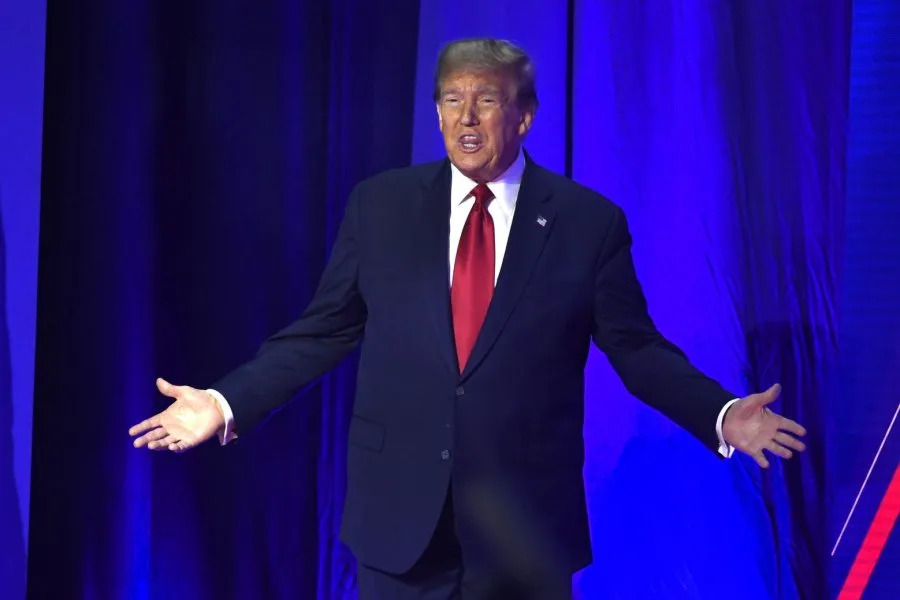Arlette Saenz and Betsy Klein – March 2, 2024
First lady Dr. Jill Biden isn’t holding back as her role in her husband’s reelection campaign comes into sharper focus.
Though the first lady has offered critiques of Republicans and former President Donald Trump in the past, her remarks at an Atlanta event Friday to mobilize female voters marked a clear shift – and her willingness to take the gloves off.
“I’ve been so proud of how Joe has placed women at the center of his agenda. But Donald Trump?” the first lady said to boos. “He spent a lifetime tearing us down and devaluing our existence. He mocks women’s bodies, disrespects our accomplishments and brags about assault. Now he’s bragging about killing Roe v. Wade.”
The first lady continued: “He took credit again for enabling states like Georgia to pass cruel abortion bans that are taking away the right of women to make their own health care decisions. How far will he go? When will he stop? You know the answer: He won’t. He won’t.”
As the first lady embarks on a three-day, four-stop battleground state campaign swing, launching the “Women for Biden-Harris” coalition, her role in the reelection effort is becoming clearer. The campaign is looking to use a top surrogate to organize – and mobilize – female voters heading into the general election, all while delivering a clear message about Trump.
“Donald Trump is dangerous to women and to our families. We simply cannot let him win,” she said in Atlanta.
The first lady is also traveling through Arizona, Nevada and Wisconsin, and she’s expected to court Black and Latino communities as the campaign looks to make inroads with those key demographic groups.
Much of the first lady’s work in the early stages of the campaign has focused on crisscrossing the country for fundraisers, but in the months ahead she’s expected to become a more frequent presence on the trail advocating on behalf of her husband and his agenda.
The first lady has long said that she’s not a political adviser to the president, instead explaining to CNN that she helps her husband by relaying what she sees and hears from people on the road. But she is his most trusted partner and holds influence in the White House and campaign. She sits in on some of the president’s political meetings and hiring decisions for some key staff, sources familiar with the matter said, and is eager to hit the road to push for a second Biden term.
The first lady is juggling her campaign work with her official role and her full-time teaching job at Northern Virginia Community College. While she took a break from teaching for part of 2020 to focus on the campaign, there’s no indication just yet that she’s decided to do the same this year. The campaign is looking to hire staff to support the first lady as she ramps up her outreach, a source familiar with the plans said.
A majority of her travel in 2024 will be stateside with campaign season in full swing, but it’s possible she could travel alongside the president to the G7 summit in Italy in June, as well as attend the Paris Olympics, according to a source familiar with her plans.
How to use a less-divisive Biden
Jill Biden was an active surrogate on behalf of her husband in 2020 and campaigned for Democratic candidates down the ballot during the 2022 midterm elections. As she’s traveled the country to promote the administration’s initiatives, she’s appeared in a mix of red states and more moderate areas and is expected to take a similar approach in 2024.
“She’s not going to just go to deep, deep blue areas. She’s going to go to a variety of areas in this country,” a source familiar with the planning said.
Biden campaign advisers believe the first lady’s appeal has far reach – particularly with women and grassroots supporters and in moderate parts of the country.
“The first lady’s trusted voice has been critical in reaching the voters who will decide this election. As a mom, grandmother, and educator, the first lady is uniquely able to reach and relate to core constituencies and effectively communicate the President’s message to the American people,” Biden campaign manager Julie Chavez Rodriguez told CNN in a statement.
Like many first ladies who have come before her, Biden is making her pitch as a surrogate who is significantly more popular than her husband. A recent CNN poll conducted by SSRS found that 59% of respondents had an unfavorable opinion of the president, compared with 30% who viewed the first lady unfavorably. As a less polarizing and relatable figure, the first lady is now being deployed to sell her husband’s policies and candidacy to the critical coalition of women that he’ll need once more in November.
Female voters made up a key part of the president’s 2020 coalition – he won 57% of female voters, who made up 52% of all voters in the 2020 election, according to CNN exit poll data.
“Women for Biden-Harris” is the first coalition effort the campaign has launched as it hopes to use the days around Super Tuesday to mobilize voters. The women-focused effort will include organizing calls from campaign surrogates and digital ad buys targeted toward women. This will include digital ads from the first lady’s swing, marking the first time she and her campaign work will be a central focus of an advertising push this cycle.
The push for female voters was on display in Atlanta on Friday as the first lady encouraged women to use their voices to organize heading into November.
“We’re going to do what we did in 2020 and 2022. We’re going to talk to our friends, and we’re going to tell them why this election is so important. We’re going to tell them what’s at stake. Sign up for phone banks and canvassing shifts. We’re going to meet this moment as if our rights are at risk because they are. As if our democracy is on the line, because it is,” she said.
Dr. Biden, who is the first presidential spouse to keep her full-time job teaching English at a community college, often approaches her speeches from that teaching experience, trying to distill policy issues for voters in “real terms.” She’s also expected to leverage her personal background as a working mother and grandmother to connect with female voters, tapping into common threads in their lives to talk about the power of women.
“Here’s the thing about men like Donald Trump – they underestimate our power because they don’t understand it,” she said in Atlanta. “They see us working night shifts and making grocery lists, driving to soccer practices and volunteering, caring for parents and raising money for those in need, and they think we can be ignored. They don’t know that our to-do lists are our battle maps.”
“When our daughters’ futures are at stake, when our country and its freedom hangs in the balance, we are immovable and unstoppable,” she added.
On Saturday, the first lady was confronted with an issue that has caused frustration within parts of the Democratic Party – the president’s handling of the Israel-Hamas war. She was interrupted several times by pro-Palestinian protesters as she spoke in Tucson, Arizona, at an event for Arizona List, which works to elect Democratic women who support abortion rights.
Taking on Trump
Jill Biden’s willingness to hit the campaign trail aggressively – and to support a reelection campaign, her husband’s fourth and final presidential bid – stems in part from the president’s predecessor and expected opponent, she told journalist Katie Rogers in an interview for her book, “American Woman,” which explores the role of the modern first lady.
“I would rail against injustice if I feel like somebody who would be Joe’s opponent would not be a good thing for this country,” the first lady told Rogers when asked about Trump being the possible Republican nominee. “I think I would work even harder.”
As she prepared for her first speech of this week’s campaign swing, the first lady specifically wanted to tap into the feelings many Democrats had when Trump beat Hillary Clinton in the 2016 race to remind voters about what’s at stake in November’s election, a source familiar with her thinking said.
“We can’t wake up on November 6 like we did in 2016 terrified of the future ahead of us, thinking, ‘My God, what just happened? What are we gonna do now?’’” she said. “We must reelect Joe Biden and Kamala Harris.”
Many of her critiques of her husband’s predecessor this campaign season have come in off-camera fundraisers. In one of her first fundraisers of the campaign, she expressed shock that Republicans appeared to continue supporting the former president as he faced his first indictment.
In the hours after Trump called on Republicans in a social media post to block the president’s hard-fought bipartisan border package this year, Jill Biden fired back, telling a group of donors in Houston, “Trump is trying to do everything he can to make Joe look bad, you know, even at the lives – sacrificing lives of so many people just for his own political gain.”
The first lady, a fierce defender of the president, has also pushed back on other critiques of her husband, including from special counsel Robert Hur, whose report questioned the president’s mental faculties while noting that he couldn’t remember the year their son Beau Biden passed away from brain cancer.
That detail struck a nerve with the Biden family, and the campaign channeled the first lady’s frustration into an email sent in her name to defend her husband and call out “inaccurate and personal political attacks against Joe.” The personal missive, which only featured a donate button at the end and did not include a specific contribution ask from the first lady, became the campaign’s second most lucrative email since the president’s launch announcement.
Influence and issues
With her efforts on the trail, Jill Biden joins a long line of first ladies who have campaigned for incumbent presidents seeking a second term. That role comes with an inherent ability to influence public perception of their husbands.
“A first lady definitely has that opportunity and privilege, really, to soften the messages – even the hardest messages,” said Anita McBride, who served as a top aide to former first lady Laura Bush.
Biden is confronting challenges to women’s health care and reproductive rights, an issue her husbad’s campaign is making a centerpiece of its strategy to attract moderate voters.
While Vice President Kamala Harris is the administration’s lead voice on the topic, the first lady is also using her platform, meeting with women affects by the Supreme Court’s Dobbs decision that overturned Roe v. Wade and extending an early invitation to the State of the Union address to Kate Cox, the Texas mother of two who had to leave her state to seek an abortion to end a life-threatening pregnancy. She’s spoken about abortion in personal terms, recounting how she helped a high school friend recover from an abortion in the era before Roe v. Wade.
“Women will not let this country go backwards,” the first lady said. “We’ve fought too hard for too long. And we know that there is just too much on the line.”
She approaches the conversation from a practical, less political standpoint.
“It’s just the nature of the job of first lady – that is probably the only person who’s campaigning for the president that could really find the windows of opportunity to rise above the politics, turn down the heat a little bit, appeal to people’s sensibilities and compassion for each other,” McBride said, adding that Biden is able to speak to more controversial issues such as abortion in a “humanizing way, and just a less combative way” than elected politicians.
The first lady is also looking for ways to interact with people in the community, aside from formal events and campaign speeches.
Before leaving Atlanta on Friday, she visited 3 Parks Wine Shop, a small business owned by a Black woman, to hear about its work and the neighborhood while also partaking in a wine tasting.
The first lady decided to take two bottles – a red and a white – for the plane ride out West. And as the group members sampled a sauvignon blanc, they raised their glasses to a campaign season toast: “To 2024.”









